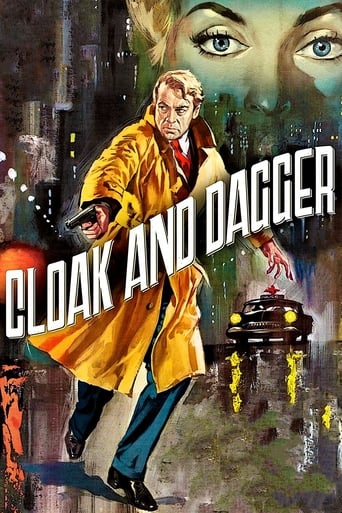lasttimeisaw
Singing an ode to O.S.S. right after the end of WWII, Fritz Lang's black-and-white Hollywood espionage thriller a bit more piquant than an adequate potboiler thanks to a dapper Gary Cooper valiantly takes on the role of Prof. Alvah Jesper, a scientist-turned-amateur-spy, ham-handed but always bullish on the prospects. During the heyday of WWII, knowing that his former colleague, the distinguished nuclear scientist Katerin Lodor (Thimig) is working for Germany, fellow scientist Mr. Jesper volunteers to touch base with her in Switzerland and tries to dissuade her from her involvement, but a tenderfoot Jesper bungles the mission and Katerin is dispatched in the action, chastened by the aftermath, he is given a second chance to rescue another scientist, the Italian professor Polda (Sokoloff) in Rome who is under rigorous surveillance by the Gestapos, the situation is more exacting and parlous notwithstanding, Jesper doesn't refrain from taking his chance to woo Gina (Palmer), a hardened partisan fighter, and slowly makes her thaw out from a bitter and cynical facade, before a final smack-down lurking near the coda and not everyone is able to get out to see the daylight. Truth to be told, this pre-Bond spy flick is too anodyne and mawkish albeit Mr. Lang's handsome mise-en-scène shimmering with a quintessential noir-ish luster, the most riveting moment is a black cat's scare in the darkness, but the tension soon is eclipsed by the romantic pas-de-deux, tentatively burrowing into the mental hardship in wartime through Gina's wounded psyche, and Ms. Palmer doesn't make her Gina sitting and pining in a thankless love interest role, that is something bracing to watch. Max Steiner's full-blown score is sonorous but effective, and the fitful fistfight actions are primordially unconvincing, but, on a brighter side, one can hardly resist the charm of a come-hither Cooper meekly does the bidding of a heroine governed by either paranoia or acumen, and after all, the Allies haven't descended to the same "better-dead-than-alive" approach carried by the evil antagonists when an ominous crunch transpires, indeed, it is an anonymous commodity fabricated out of Hollywood's booster-ism of patriotic selflessness, added with a soupçon of zest in a maestro's hands.
Leofwine_draca
Fritz Lang is the director behind this fun wartime thriller, in which US academic Gary Cooper is sent to Switzerland to track down a nuclear scientist who's been coerced into working for the Germans. His goal is to prevent the Germans and the Italians from getting their hands on the methods to build a nuclear bomb, to which end he must work with the Italian resistance and combat many enemies along the way.This is a lively little picture for the most part, not dissimilar to a Hitchcock film like FOREIGN CORRESPONDENT. It's all propaganda of course, but that's no bad thing when you have an assured hand like Lang at the helm. The main thing that prevents CLOAK AND DAGGER from being a classic is a stodgy and extremely dull romantic sub-plot in which Cooper falls in love with one of his allies. This drags the story down in the second half and it only comes to life again for the climax.Still, it is a film worth watching, not least for some truly impressive and ahead of their time fight scenes. Lang shoots these fights in a shockingly brutal way for the 1940s, all below the belt hits and attempts to gouge and murder the rival fighter. They're good enough to stand up with the best of modern cinema, so it's just a shame that the rest of the production couldn't match this type of pace and excitement consistently.
kenjha
This WW2 espionage yarn gets off to a slow start but picks up steam after the action shifts to Italy and Palmer enters the picture as Cooper's love interest. Cooper acts with his usual awkwardness but in this case his uneasiness is well suited to the role of a scientist out of his element. As an Italian resistance fighter, Palmer gives a wonderfully natural performance. Although the opening credits oddly indicate that this is her film debut, she had been acting for a decade. The best parts of the film are her scenes with Cooper. The fight scene between Cooper and Lawrence is reminiscent of Hitchcock. Lang made this at the time when he was at the peak of his creative powers.
hickey2
While this is probably the first Fritz Lang film I wasn't overwhelmingly impressed with (well, maybe Siegfried, too), it does have a couple of things that make it really worth watching. Cooper's fury as a scientist early on in the movie railing against the amount of money the government pays for the development of killing machines, as opposed to curing diseases and making the world a better place, is beautiful and gave me chills. It's an incredibly powerful expression of grief and outrage in the wake of the bombings of Hiroshima and Nagasaki (this movie came out only a year after the end of the war). Also, there's an INCREDIBLE fight scene late in the movie, in which Cooper's character (who's really a professor, and just an ordinary man, not a hardened fighter) struggles with an Italian spy. I don't think Lang is known for his fight scenes, but this one is a masterpiece. There's no Jackie Chan flying over tables, swinging on chandeliers, or kicking people through walls; instead, you have an ordinary man struggling with a somewhat superior opponent, in a very realistic, very brutal fight scene. A lot of small, practical self-defense moves I remember my dad teaching me when I was young are employed in this fight, including stomping on someone's instep and a couple of simple arm grapples. The action is extremely believable and practical, and the combat is savage, between two men fighting desperately for their lives. No one watches Fritz Lang movies for the fight scenes, but this one's really one of the highlights of this otherwise "eh" film--it's extremely well-done, and very surprising for a 1940s movie.


